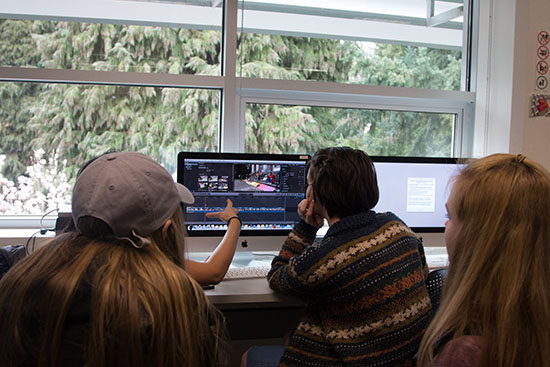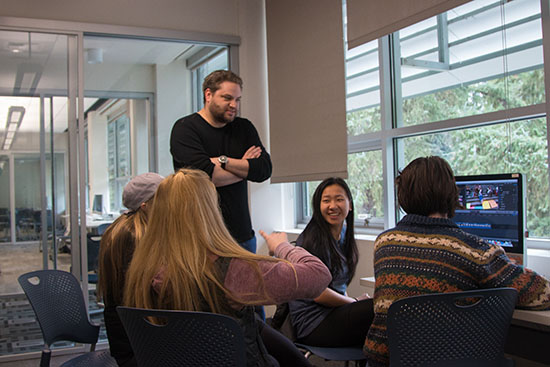Much has been said about the challenges that communication professionals have faced on their journey into the digital age. But in some ways, journalism educators have had it even harder. It’s one thing to learn to communicate via new media and platforms, but quite another to teach hundreds of students how to use all those tools — not to mention the many new technologies coming down the pike — on top of the fundamentals, like storytelling, grammar, ethics and accuracy.
“When we began re-envisioning our entire curriculum more than a decade ago, we realized that if we wanted our students to succeed in the rapidly evolving digital maze, we would have to completely blow up how we taught journalism and communication,” said Julianne Newton, interim Edwin L. Artzt Dean of the School of Journalism and Communication at the University of Oregon (UO). “But we had to answer some questions first. How do you keep your curriculum updated when the media market’s cycle of change is so much faster than academia’s? Do you require all students to learn all the skills, or do you let them opt in with electives? And how do you keep students focused on becoming good journalists and media professionals rather than on the bells and whistles of new tools?”
The UO J-School’s solution was to design a 12-credit, three-course sequence integrating previously separate courses in writing, information gathering and visual communication. Students across all areas — journalism, advertising, public relations and media studies — start their major coursework in an intensive multimedia storytelling experience called Gateway to Media. It’s a digital storytelling boot camp that grounds them in foundational concepts, practices and skills before they advance to specialized tracks.
“In the first two courses, we focus on multi-platform journalistic storytelling and teach audio, photo, video, words and web,” said Lisa Heyamoto, coordinator of the Gateway program. “In the third course, we shift the focus to strategic storytelling and cover multimedia, design and social in that context. But all assignments point toward developing good stories.”
This “gateway” approach addresses two goals: It teaches students enough to make educated decisions about what to specialize in later. And it gives them practice in telling a story in different ways, giving them versatility that’s invaluable once they hit the workplace. It’s a model many of the top J-schools — including UO, University of Wisconsin-Madison and University of Texas at Austin — now use.
Want to start a digital journalism gateway course at your school? Here are seven tips from those who have led the way.
1. Focus on Storytelling
Whether students go on to be long-form journalists, documentarians, ad copywriters or a PR people, the number-one skill they will need is the ability to communicate a story in a way that engages both reason and emotions. That commonality offers a powerful focal point for a digital communication course.
“Storytelling cuts across all areas, so we frame Gateway as a multi-platform storytelling class,” Heyamoto said. “That way it uses a common language for all of the different majors. We teach everybody journalistic and strategic storytelling, and we try to convey the message that great storytelling is about more than knowing how to use the tools.”
2. Aim for T-shaped Graduates
“Journalism changes constantly,” said Stacy Forster, one of three instructors who teach Mass Communication Practices, a 6-credit digital communication course at UW-Madison’s School of Journalism and Mass Communication. “When students go out into the world, having a good foundation in various skills makes them more valuable in the workplace.”
According to UO’s Heyamoto, that foundation is the horizontal cap of the “T” shape that represents a well-rounded student. “But at some point, you need to specialize. If your specialty is writing, that’s the long part of your T, but you can also take photos,” she said. “You may not be the one shooting the video, but you need to know how to communicate what you want to the person who is.”
3. Emphasize Digital Agility
The list of platforms communicators must learn is long and constantly in flux — from video and podcasts to social media, mobile apps, interactive infographics and virtual reality. Yet technology is not the most important part of a digital skills boot camp.
Because today’s tool du jour might be obsolete by the time your students graduate, what they really need are the critical thinking skills to decide which channels, tools or media are best suited to tell the story and engage the intended audience. “If you think back, people were taking courses in Flash, but that changed,” said R.B. Brenner, director of UT-Austin’s School of Journalism and an instructor for the Digital Storytelling Basics class that journalism majors take as freshmen. “With Google and YouTube, you can learn the tools. So what we focus on is instilling a digital mindset from the very beginning.”
Video editing is a valuable skill for today’s journalists. But gaining digital agility — the ability to decide which media suit a given story and to learn new technologies on the fly — will serve students best in a constantly changing media environment. Photo courtesy of UO School of Journalism and Communication.
4. Give Them Real-World Experience
Anyone who has held an internship knows that doing real work in the trenches offers invaluable experience no classroom assignment can match. That’s why the third course of UO’s Gateway sequence pairs student teams with local nonprofits for a real-world client experience that benefits students while building relationships in the community.
“The whole term, all of their projects are geared for their client,” explained Heyamoto. “They make a creative brief, an infographic, a multimedia piece and a social media plan. The clients are most excited about the multimedia piece, but they get a lot of great stuff they might actually use. And the students get to work with a client with real needs.”
Using their new skills to solve a real problem for an authentic audience ties it all together for the students. “The basics were covered in class, but we were encouraged to teach ourselves and learn on the fly,” Madi McCallum, a 2014 UO graduate who is now an associate producer for the advertising agency R/GA, wrote in an email. “It put all the skills we’d learned to the test, and I felt like I grew a lot as a young, aspiring journalist.”
5. Develop Strategic Thinking and Understanding of Audience
While advertising, marketing and PR writers need a journalist’s grasp of a good story, journalists benefit from a strategic communicator’s understanding of market and audience. That’s why UO’s Gateway program and UW-Madison’s Mass Communications course require students from all majors to learn both journalistic and strategic storytelling.
“In a media landscape populated with an astronomical number of channels competing for limited attention spans, you’ve got to target your audience,” Heyamoto said. “No good journalist just writes a story for everybody without thinking about who they’re talking to. And the lines between journalism and strategic communication have never been blurrier. A journalist might write sponsored content, or an ad major will create native ads. We’re laying a foundation so everyone understands how everything is integrated.”
To that end, the capstone project for UW’s digital journalism class is creating and pitching a website or app to a panel of “angel investors.” “They work together to come up with an idea and build a comprehensive site with persuasive and informational content and multimedia features,” said Forster. “They get the experience of entrepreneurship and exposure to a lot of different forms of writing and production.”
6. Teach Teamwork
In addition to experience with digital communication tools and platforms, any media organization, agency or corporate communication department will expect new employees to walk in the door with collaboration skills.
Fortunately, the team environment is easy to replicate in a classroom and has added benefits for students. “At UO, we run our students through Gateway in cohorts, which has a lot of advantages,” Heyamoto said. “It helps them advance projects because they tend to have complementary skills: A strong writer might team up with a great videographer to make something that’s better than either could do on their own. It also helps them make connections that carry them through school and out into the world.”
Because content is often produced in team environments, collaboration skills are just as important as communication skills. Photo courtesy of UO School of Journalism and Communication.
7. Assign Content Packages
Because different platforms engage different audiences, most agencies and media outlets want content producers to envision each topic using a variety of approaches.
UW-Madison gives students hands-on experience creating journalistic story packages one piece at a time over the course of a semester. “They pick a topic on campus and spend most of the semester researching it, doing interviews and putting together a package of content,” Forster said. “There’s a long feature story, an alternative format form, an audio story and an audio slideshow.”
In another approach to multifaceted storytelling, UT-Austin’s Digital Storytelling Basics course has students “break” news following the additive approach that many media organizations now use. “We’re in the atomic-unit-of-news age, where the story begins with a push notification or alert, then a one-sentence Twitter or Facebook post,” Brenner said. “Then you write two paragraphs to get it on the web, and the story starts growing atomically from there — the pivot from speed to depth.”
Your students’ education won’t end when they leave school. But as journalism educators, you can give them a good start with a toolbox of digital skills, critical and strategic thinking practice, and the confidence to keep trying new things.
Andra Brichacek is a writer and editor working in the School of Journalism and Communication at the University of Oregon. She has 18 years’ experience creating content for print and online media and has specialized in education since 2008. Follow her on Twitter @andramere.















